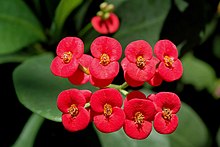Euphorbia milii
| Euphorbia milii | |
|---|---|

| |
| Scientific classification | |
| Kingdom: | |
| (unranked): | |
| (unranked): | |
| (unranked): | |
| Order: | |
| Family: | |
| Genus: | |
| Species: | E. milii
|
| Binomial name | |
| Euphorbia milii | |
Euphorbia milii (crown of thorns, Christ plant, Christ thorn) is a species of flowering plant in the spurge family Euphorbiaciae, native to Madagascar. The species name commemorates Baron Milius, once Governor of Réunion, who introduced the species to France in 1821.[1] It is suspected that the species was introduced to the Middle East in ancient times, and legend associates it with the crown of thorns worn by Christ.[1] It is also found in Kerala, India. There is a tale stating that there were Jews living in Kerala and they brought the Christ thorn plant from Israel to India.[citation needed]
Description
It is a succulent climbing shrub growing to 1.8 m (5 ft 11 in) tall, with densely spiny stems. The straight, slender spines, up to 3 cm long, help it scramble over other plants. The leaves are found mainly on new growth,[1] and are obovate, up to 3.5 cm long and 1.5 cm broad. The flowers are small, subtended by a pair of conspicuous petal-like bracts, variably red, pink or white, up to 12 mm broad.[2] The sap is moderately poisonous, and causes irritation on contact with skin or eyes. If ingested, it causes severe stomach pain, irritation of the throat and mouth, and vomiting. The poison contains 5-deoxyingenol. [citation needed] Wat Phrik in Thailand claims to be the home of the world's tallest Christ thorn plant.[3]
This plant has gained the Royal Horticultural Society's Award of Garden Merit.[4]
Varieties
E. milii is a variable species, and several varieties have been described; some of these are treated as distinct species by some authors.[2] E.milii var.splendens (syn. E.splendens) is considered to be the living embodiment of the supreme deity in Bathouism, a minority religion practiced by the Bodo people of Eastern India and Nepal.

- Euphorbia milii var. bevilaniensis (Croizat) Ursch & Leandri 1955
- Euphorbia milii var. hislopii (N.E.Br.) Ursch & Leandri 1955 (syn. E. hislopii)
- Euphorbia milii var. imperatae (Leandri) Ursch & Leandri 1955
- Euphorbia milii var. longifolia Rauh 1967
- Euphorbia milii var. milii
- Euphorbia milii var. roseana Marn.-Lap. 1962
- Euphorbia milii var. splendens (Bojer ex Hook.) Ursch & Leandri 1955
- Euphorbia milii var. tananarivae (Leandri) Ursch & Leandri 1955
- Euphorbia milii var. tenuispina Rauh & Razaf. 1991
- Euphorbia milii var. tulearensis Ursch & Leandri 1955
- Euphorbia milii var. vulcanii (Leandri) Ursch & Leandri 1955
Gallery
-
Euphorbia milii var splendens
-
Stamens and carpels
-
Euphorbia milii var. splendens
-
Euphorbia milii
-
Euphorbia milii var. vulcanii
-
Euphorbia milii var. milii
-
Cross-section of the cyathium
-
Grown in Malaysia
-
Close-up view of Euphorbia milii
-
Christ plant
-
In Prague botanic garden
-
Euphorbia milii from Flower View
-
Euphorbia milii from Kerala, India
-
Euphorbia milii red coloured grown in garden
References
- ^ a b c Ombrello, Dr T., Crown of Thorns, Plant of the Week, UCC Biology Department, retrieved 1 October 2009
- ^ a b Huxley, A., ed. (1992). New RHS Dictionary of Gardening. ISBN 0-333-47494-5
- ^ ThaiTambon.com
- ^ "RHS Plant Selector - Euphorbia milii". Retrieved 7 July 2013.















